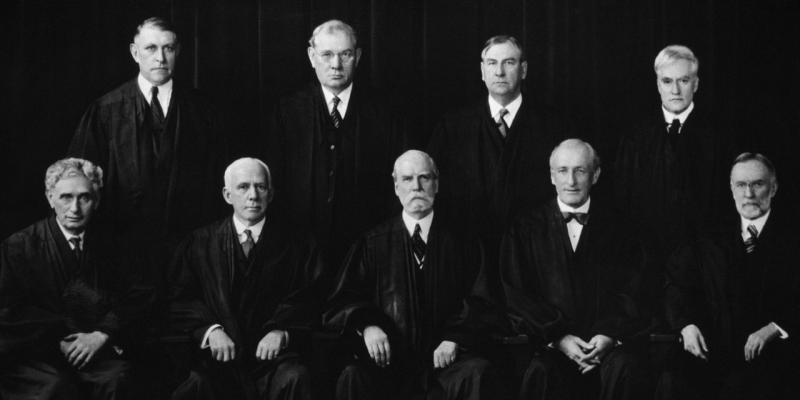'FDR's Gambit' Review: Playing the Numbers
By: Adam J. White (WSJ)



The judiciary, Alexander Hamilton warned, "is in continual jeopardy of being overpowered, awed, or influenced by" the political branches of government. Never more so than in 1937. That year, President Franklin Roosevelt waged political war against a Supreme Court that had stifled his ambitious New Deal policies. He urged Congress to add six new justices to the nine-member court, creating a body that would overturn its recent decisions and align the court with his political agenda. FDR was at the height of his prewar authority, and the court's counter-majoritarian decisions had put the institution in genuine peril. But in the end FDR was thwarted by his fellow Democrats, who recognized the scheme's anti-constitutional stakes.
For nearly a century since this episode, "court-packing" has been an infamy in American politics. Eventually, writes Laura Kalman, "1937" became "a parable for those who sought to make claims about the relationship between law and politics." But Ms. Kalman, a historian of politics and the Supreme Court at the University of California, Santa Barbara, would draw different lessons from history. In "FDR's Gambit: The Court Packing Fight and the Rise of Legal Liberalism," she seeks to "challenge the conventional wisdom" about FDR's attacks. She sees not presidential overreach but "shrewdness." And Ms. Kalman's account is thorough: From congressmen to administration officials to judges to columnists to pollsters to interest groups, "FDR's Gambit" recounts seemingly everyone who supported, opposed or analyzed Roosevelt's war on the court.
FDR undertook his political campaign after the court declared parts of the New Deal unconstitutional. For decades, libertarian justices had eagerly struck down progressive economic regulations in the states, under an expansive view of constitutional liberty protected by the 14th Amendment. After Roosevelt’s election, the New Deal received similar judicial scrutiny—and not just from the conservative justices. On May 27, 1935, a day that would be known as “Black Monday,” the court unanimously ruled against the Roosevelt administration in three major cases involving executive power or federal legislation. A year later brought the court’s 5-4 decision in Morehead v. Tipaldo, nullifying New York’s minimum-wage law. The decision, which drew criticism even from Republicans, created a regulatory “twilight zone,” as FDR put it, “an ungovernable ‘no man’s land’ ” beyond the power of legislatures.
The president could have responded by campaigning for a constitutional amendment that codified his preferred view of the legislatures’ regulatory powers; after smashing the GOP in the 1936 election, he had immense popular support. Instead, he campaigned to change the court itself, by expanding it. Packing the court would merely require legislation, because the Constitution does not set the court’s size; Congress does.
FDR argued throughout 1937 that the court’s decisions justified radical change. Did they? “FDR’s Gambit” offers little guidance. Ms. Kalman recounts the political controversy that surrounded the cases as well as the contending partisans’ characterizations, but she offers only brief accounts of the actual issues and of the justices’ arguments.
Sometimes brevity comes at the cost of nuance, particularly in her treatment of Schechter Poultry v. U.S., one of the Black Monday cases. The court unanimously held that the National Industrial Recovery Act’s broad delegation of lawmaking power to the president and industry groups violated the Constitution’s separation powers. Ms. Kalman writes that Chief Justice Hughes’s opinion for the court was “unmoved by any of the government’s points” and insisted that “extraordinary conditions do not create or enlarge constitutional power.” In fact, Hughes was referring to the administration’s own arguments, citing a 1917 precedent: “An emergency may not call into life a power which has never lived,” the government had conceded in its brief.
Ms. Kalman does not hesitate to raise doubts about FDR’s own rhetoric. He insisted that he was not attacking the Constitution, or even the court per se, but rather seeking to supplement the old justices on the court. Yet his unguarded remarks, the author writes, gave good reason “to think that the president did not have much use for the Constitution.” The administration’s arguments suggested “that FDR sought judicial subservience.”
The Senate ultimately rejected his legislative push and averted the crisis, after the court issued key decisions in later cases upholding New Deal laws. (Whether the court’s pivotal justices reached those decisions in good faith, or out of political self-preservation, remains a subject of debate.) Ms. Kalman concludes that FDR’s gambit was less reckless than it seems: “The court bill, in some form or another, had a better chance of enactment in some form than most scholars have concluded.” Even if true, this would be the faintest possible praise for a needless crisis that risked destroying the federal judiciary as a credible constitutional institution.
Today some critics of the Roberts Court are eager to pack the court with progressive justices. (In 2021, President Biden created a commission to study the history of court-packing and other court-curbing initiatives; I was among its members.) Whatever her own conclusions might be, Ms. Kalman’s narrative offers an important lesson: Political narratives about the Supreme Court can be entrenched astonishingly fast, setting the stage for political attacks on it.
In 1936 Drew Pearson and Robert Allen’s book “The Nine Old Men” had “codified the caricatures of and gossip about” the justices themselves as old, out-of-touch reactionaries. Two years later, the critical narrative against FDR’s court-packing gambit was largely “calcified” by Joseph Alsop and Turner Catledge’s 1938 “instant history,” “The 168 Days.” If a war against the court can begin as a war over how to define the court, then recent efforts to fix a narrative about the Roberts Court as anti-democratic reactionaries should not be dismissed lightly.
Mr. White is a senior fellow at the American Enterprise Institute, and co-director of the Antonin Scalia Law School’s Gray Center for the Study of the Administrative State.




I once knew a woman who was a huge FDR fan and a big liberal. She was proud of a thesis she wrote in college commemorating the FDR presidency. She never knew, until I told her, about FDR trying to pack the Court. Try to imagine that.
The Book is:
FDR's Gambit: The Court Packing Fight and the Rise of Legal Liberalism
One of the most reckless and dangerous moves ever attempted by a power mad President.
If FDR could only see what the left is accomplishing today!